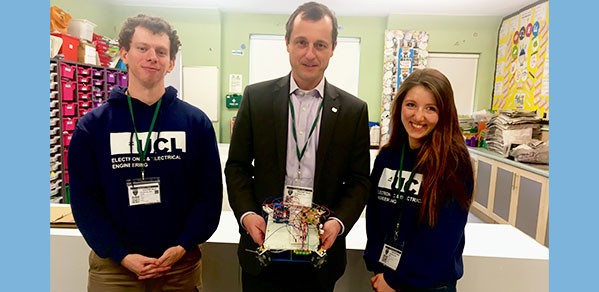
Jana Skirnewskaja is researching holographic augmented reality (AR) head-up displays for use in cars. She was recently awarded a research scholarship to support her outreach work and efforts to engage with the next generation of scientists.
All of the experiments were designed to engage the children in a discussion to explore the origins of phenomena such as thunderstorms, rainbows and gravity. It was rewarding for the outreach team to hear the children saying, “I hope to see you during the next science fair”.
PhD student Jana Skirnewskaja
Jana, who conducts her PhD research at the EPSRC Centre for Doctoral Training (CDT) in Connected Electronic and Photonic Systems, a joint centre with the University of Cambridge and UCL, was selected for the scholarship following a successful interview process by the Worshipful Company of Scientific Instrument Makers.
Jana intends to use the scholarship funding to purchase virtual reality (VR) headsets for use by members of the public so that she can showcase her research findings in an interactive way.
Using the VR headsets, she will project LiDAR (light detection and ranging) 3D holographic objects as road obstacles as part of an integrated transportation experience. It involves using previously gathered LiDAR data from some of her earlier collaborative research to create ultra-high-definition holographic representations of road objects, which are beamed directly to the driver’s eyes, instead of 2D windscreen projections used in most head-up displays. Tests on a prototype version of the technology suggest that it could improve road safety by ‘seeing through’ objects to alert of potential hazards without distracting the driver.

Jana attends the award ceremony of the Worshipful Company of Scientific Instrument Makers Freemen Admission to accept her scholarship certificate.
Here, in her own words, Jana shares details of one of her more recent outreach activities which had the theme ‘A day in the life of a scientist’, set up to engage and inspire schoolchildren as part of a week-long science fair:
Communicating through light, building magnets, helping an Arduino-programmed robot find its way through a labyrinth and creating static hair are just some of the experiments carried out during science week at St Benedict’s School, in London. The experiments, conducted by myself and the outreach division of the UCL-Cambridge CDT in Connected Electronic and Photonic Systems and UCL members, were carefully planned to ensure a diverse technical level and to raise the children’s interest, encouraging them to dive further into any of the presented topics.
The entire week was filled with scientific hands-on experiments which were carried out with the involvement of the children. The ‘communicating through light’ experiment involved a self-made transmitter and a self-made receiver to receive the light signal. Two types of experiments took place; one with a cable to mimic local area network (LAN) internet and one that was wireless, where the transmitter light had to be specifically oriented towards the small bulb of the receiver to mimic Wi-Fi. This process showed the children first-hand, the challenges in the optical communication research field.
The second experiment involved the science of magnetism. A demonstration was given showing a long rod made from copper, which is non-magnetic, and a small magnet that fits into the rod opening. First, the magnet was shown to be attracted to metallic surfaces, but when the children were asked how the magnet would behave when sent through the copper rod, only a few of them came close to the result.
It was interesting to discuss potential outcomes and see how the children examined a scientific topic. The magnet neither sticks to the copper rod nor does it completely fall through the rod. By creating a weak magnetic field, which must fight against gravity, the magnet very slowly reached the end of the copper rod compared to a non-magnetic object. The children were then divided into groups and asked to build their own magnets. A copper wire was wrapped around a coil as much as the children felt necessary. Later, the demonstrators attached the wire to a battery and tested the magnet with a steel block, enhancing the properties of the magnet and how it compares with a non-magnetic material experiment. This gave room for discussion about real-life examples of magnets.
A third experiment involved estimating different weights with the same packaging and experiencing first-hand the science of metrology. There were many guesses before the results were measured with scales and it was a great discussion. The last experiment for the day was to explore static electricity. Each student rubbed a balloon on their own hair, before attempting to stick it to a surface.
All of the experiments were designed to engage the children in a discussion to explore the origins of phenomena such as thunderstorms, rainbows and gravity. The older age groups of nine to 12-year-olds explored more complicated scientific experiments using, for example, pre-programmed Arduino robots to detect different signals, including sound and vision. If you clapped once, the robot would move forward for one second and when it came to testing if the robot could detect a straight line, the robot would show that it could by moving along this line.
The experiment was designed to demonstrate different technological possibilities to the children and to engage them in the topic of sensors and the development of novel technologies for everyday life. They were already familiar with block-based programming and were asked questions with regards to how the robot could navigate a labyrinth. The children were given time to elaborate on their own ideas and some remarkable questions on programming possibilities were explored.
It was rewarding for the outreach team to see the smiling faces of the children saying, “I hope to see you during the next science fair”. Additionally, the outreach team would like to engage with more schoolchildren on science-related topics and we hope to organise further experiments that continue to spark fruitful discussions.

